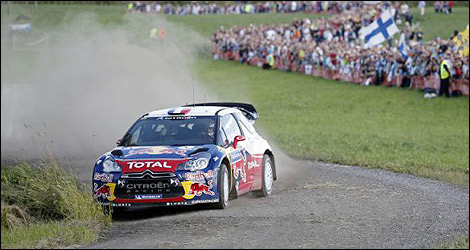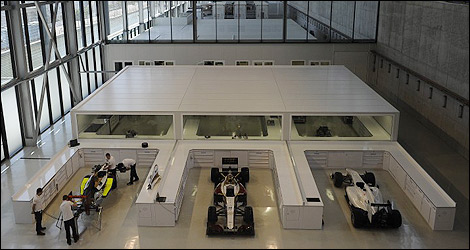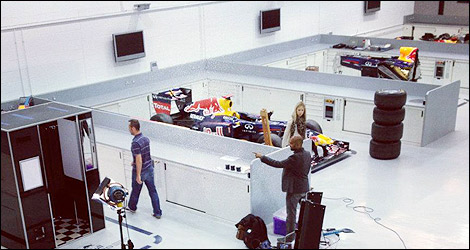Aug
3rd
Stay connected Subscribe to our RSS feed
When General Motors slashed and burned a few divisions a couple of years ago following the government's financial aid to save the ailing company, a lot of people probably wondered why Buick didn't get thrown into the fire alongside Pontiac, Saturn and Hummer. For those who don't already know, Buick is big in China: that's right, what is arguably the biggest emerging market in the world loves the brand.
As a result, Buick got a new lease on life in North America and the Regal GS, new for 2012, is the most tantalizing Buick currently available. Ah, the Gran Sport name recalls some fine classic machinery from the muscle car era. Yet, as a modern-day performance sedan, is the 2012 Regal GS worthy of its notorious badge? And more importantly, if you're in the market for a luxury sport sedan, would a Buick be on your shopping list?
The GS muscle
The 2012 Buick Regal GS gets a direct-injected 2.0L turbocharged four under its hood and produces 270 hp as well as 295 lb-ft of torque from 2,400 rpm. Those are impressive numbers for such a small engine; in fact, it's about as muscular as GM's 3.6L V6. You also get a choice between 6-speed manual and automatic transmissions. When's the last time you saw a clutch pedal in a Buick? I can't remember either, but I'm glad one's available now.
However, and like the rest of the Regal lineup, the GS drives its front wheels only. Those two rubber doughnuts have the unfortunate double duty of getting power to the ground and turning the car at the same time.
That's a recipe for torque steer in powerful front-drivers. To become a negligible issue, the engine frequently feels robbed of its full potential. We clocked a 0-100 km/h time of 7.3 seconds. Under hard acceleration, the 2.0L turbo feels about 100 lb-ft short, and you don't quite get that immediate-kick-in-the-pants feel as with VW/Audi's 2.0T engines.
Still, the Regal GS is very enjoyable, and driving fast is something you'll end up doing anyhow, because the car is so quiet inside. The turbocharger's whistle won't give you goosebumps like a good ol' V8 would, but it's music to our ears nonetheless.
Fuel economy has nothing to do with performance-oriented Buicks of yesteryear. At 100 km/h on the highway, the engine spins at just 1,800 rpm, and our combined city/highway average of 9.8L/100km is a decent result.
Stopping power is provided by four-wheel vented disc brakes, along with Brembo four-piston callipers and performance brake pads up front. The most potent Regal serves up good initial bite when you stomp on the pedal and short stopping distances.
The GS button
On the dash, you'll find Sport and GS buttons, which both stiffen the car's suspension and reduce body roll. On the open road, you likely won't feel any difference apart from a slightly jittery ride on the highway.
On the other hand, the reduced assist of the hydraulic power steering when the GS mode is active feels great when you wish to drive in a more spirited fashion. Ultimately, we think most owners will stop playing around with the buttons after a few weeks.
Yet, we shouldn't forget that this is a German-engineered sedan, and that means excellent road manners. The Regal GS, or all trim levels for that matter, benefits from good turn-in and minimal body roll. The GS probably is the greatest handling front-drive car GM has offered in North America, so far. Oh, by the way, the Regal is now built in Oshawa, Ontario.
The GS difference
It's fairly easy to distinguish a Regal GS from other versions. The vertical air intakes on the front bumper give the car a sabre-toothed smile, while a sportier rear bumper and rocker panel extensions hug 19” alloy wheels; our tester is equipped with optional chromed 20-inchers -- not a bad upgrade from a visual standpoint.
Inside, you get excellent 12-way power front seats with rich leather upholstery, a fat and grip-y steering wheel and a 5.1 surround sound system, while a power sunroof and navigation are extra-cost additions.
On the downside, the electronic parking brake is a bit of a hassle; you must flip a console-mounted rocker switch to activate and deactivate it, which doesn't always cooperate when you're in a hurry -- and forget about wintertime parking-lot drifting. Rear-seat space is snug for two adults, uncomfortable for three.
The GS price
Base price for the 2012 Buick Regal Gran Sport is $40,900, while our loaded test car, which includes the $995 White Diamond Tricoat paint (ouch!), rings in at $44,555.
The Regal GS is a solid, great-handling sport sedan that treats its occupants well and delivers decent straight-line performance and fuel economy. However, competitors such as the Infiniti G37x, the BMW 328i and the Audi A4 quattro are all within a few thousand dollars and tough acts to follow in regards to performance, handling and prestige.
And let's not forget Cadillac's new, rear-wheel drive 2013 ATS, which can be equipped with the same engine. It all comes down to this: Could you imagine yourself driving a Buick sports sedan?
As a result, Buick got a new lease on life in North America and the Regal GS, new for 2012, is the most tantalizing Buick currently available. Ah, the Gran Sport name recalls some fine classic machinery from the muscle car era. Yet, as a modern-day performance sedan, is the 2012 Regal GS worthy of its notorious badge? And more importantly, if you're in the market for a luxury sport sedan, would a Buick be on your shopping list?
 |
The GS muscle
The 2012 Buick Regal GS gets a direct-injected 2.0L turbocharged four under its hood and produces 270 hp as well as 295 lb-ft of torque from 2,400 rpm. Those are impressive numbers for such a small engine; in fact, it's about as muscular as GM's 3.6L V6. You also get a choice between 6-speed manual and automatic transmissions. When's the last time you saw a clutch pedal in a Buick? I can't remember either, but I'm glad one's available now.
However, and like the rest of the Regal lineup, the GS drives its front wheels only. Those two rubber doughnuts have the unfortunate double duty of getting power to the ground and turning the car at the same time.
That's a recipe for torque steer in powerful front-drivers. To become a negligible issue, the engine frequently feels robbed of its full potential. We clocked a 0-100 km/h time of 7.3 seconds. Under hard acceleration, the 2.0L turbo feels about 100 lb-ft short, and you don't quite get that immediate-kick-in-the-pants feel as with VW/Audi's 2.0T engines.
Still, the Regal GS is very enjoyable, and driving fast is something you'll end up doing anyhow, because the car is so quiet inside. The turbocharger's whistle won't give you goosebumps like a good ol' V8 would, but it's music to our ears nonetheless.
Fuel economy has nothing to do with performance-oriented Buicks of yesteryear. At 100 km/h on the highway, the engine spins at just 1,800 rpm, and our combined city/highway average of 9.8L/100km is a decent result.
Stopping power is provided by four-wheel vented disc brakes, along with Brembo four-piston callipers and performance brake pads up front. The most potent Regal serves up good initial bite when you stomp on the pedal and short stopping distances.
 |
| The 2012 Buick Regal GS is powered by a turbo 2.0L four that develops 270 hp and 295 lb-ft of torque. (Photo: Sébastien D'Amour) |
The GS button
On the dash, you'll find Sport and GS buttons, which both stiffen the car's suspension and reduce body roll. On the open road, you likely won't feel any difference apart from a slightly jittery ride on the highway.
On the other hand, the reduced assist of the hydraulic power steering when the GS mode is active feels great when you wish to drive in a more spirited fashion. Ultimately, we think most owners will stop playing around with the buttons after a few weeks.
Yet, we shouldn't forget that this is a German-engineered sedan, and that means excellent road manners. The Regal GS, or all trim levels for that matter, benefits from good turn-in and minimal body roll. The GS probably is the greatest handling front-drive car GM has offered in North America, so far. Oh, by the way, the Regal is now built in Oshawa, Ontario.
 |
| On the dash, you'll find Sport and GS buttons, which both stiffen the car's suspension and reduce body roll. (Photo: Sébastien D'Amour) |
The GS difference
It's fairly easy to distinguish a Regal GS from other versions. The vertical air intakes on the front bumper give the car a sabre-toothed smile, while a sportier rear bumper and rocker panel extensions hug 19” alloy wheels; our tester is equipped with optional chromed 20-inchers -- not a bad upgrade from a visual standpoint.
Inside, you get excellent 12-way power front seats with rich leather upholstery, a fat and grip-y steering wheel and a 5.1 surround sound system, while a power sunroof and navigation are extra-cost additions.
On the downside, the electronic parking brake is a bit of a hassle; you must flip a console-mounted rocker switch to activate and deactivate it, which doesn't always cooperate when you're in a hurry -- and forget about wintertime parking-lot drifting. Rear-seat space is snug for two adults, uncomfortable for three.
 |
| Inside, you get excellent 12-way power front seats with rich leather upholstery. (Photo: Sébastien D'Amour) |
The GS price
Base price for the 2012 Buick Regal Gran Sport is $40,900, while our loaded test car, which includes the $995 White Diamond Tricoat paint (ouch!), rings in at $44,555.
The Regal GS is a solid, great-handling sport sedan that treats its occupants well and delivers decent straight-line performance and fuel economy. However, competitors such as the Infiniti G37x, the BMW 328i and the Audi A4 quattro are all within a few thousand dollars and tough acts to follow in regards to performance, handling and prestige.
And let's not forget Cadillac's new, rear-wheel drive 2013 ATS, which can be equipped with the same engine. It all comes down to this: Could you imagine yourself driving a Buick sports sedan?
 The latest auto news, reviews, prices, product and vehicle releases.
The latest auto news, reviews, prices, product and vehicle releases. 



